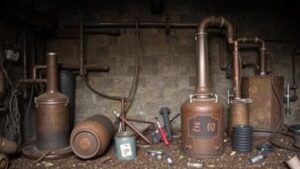Tracing Disused Blacksmith Forge Sites for Craft Tool Discoveries
Tracing Disused Blacksmith Forge Sites for Craft Tool Discoveries
The study of disused blacksmith forge sites is critical for understanding historical craft practices and material culture. These sites serve as repositories for tools and artifacts that provide insight into the technological capabilities of past communities. This article examines methodologies for locating former forges and highlights significant findings from recent archaeological investigations.
Historical Context of Blacksmithing
Blacksmithing has been a vital trade since ancient times, with evidence of metalworking dating back to as early as 3500 BCE in regions such as Mesopotamia. Throughout history, blacksmiths played a crucial role in producing tools, weapons, and other metal goods essential for daily life. The decline of traditional blacksmithing began in the late 19th century, coinciding with the rise of industrial manufacturing and changing labor dynamics.
Methodology for Site Tracing
Archaeological investigations into blacksmith forge sites typically involve a multidisciplinary approach, incorporating historical research, field surveys, and advanced technologies. Key methodologies include:
- Historical Research: Archives, old maps, and local histories are first examined to identify potential forge locations. Notable documents, such as tax records or business directories, can provide insights into active forges at various points in time.
- Field Surveys: Physical examination of landscapes is conducted to identify remnants of forge operations, such as slag, furnace remains, or distinct soil signatures.
- Geophysical Survey Techniques: Technologies like Ground Penetrating Radar (GPR) and magnetic surveys are employed to detect subsurface archeological features without intrusive digging.
Case Studies of Notable Sites
Several significant discoveries exemplify the potential of tracing disused blacksmith forge sites. For example:
The Blacksmith Shop in Colonial Williamsburg
Excavations at the blacksmith shop in Colonial Williamsburg, Virginia, uncovered an extensive collection of tools, including hammers, tongs, and specialized crafting equipment dating back to the 18th century. Archaeologists utilized documentary evidence to locate the forge, demonstrating how traditional crafts contributed to colonial economies.
The Forge at Old Sturbridge Village
At Old Sturbridge Village in Massachusetts, researchers located a working forge that produced tools used in the early 19th century. Analysis of the slag and tools found during excavations provided valuable data on the types of iron and methods used, contributing to a broader understanding of regional craft dynamics.
Tools and Artifacts Analysis
The analysis of tools and artifacts recovered from forge sites reveals distinct characteristics that reflect both the craftsmanship of the era and the technology available. For example, the presence of specific tools can indicate the type of work performed, whether it be agricultural implements or more complex machinery components.
- Tool Types: Commonly found tools include chisels, punches, and blades, each associated with specific applications in craftsmanship or manufacturing.
- Material Analysis: Metallurgical testing, such as chemical composition analysis, allows for the identification of sources of iron and variations in techniques which might indicate cultural practices.
Future Directions in Research
As the field of archaeology progresses, there are increasing opportunities for leveraging technology to streamline the process of locating and studying forge sites. For example, enhanced remote sensing technologies, coupled with machine learning algorithms, could significantly improve the efficiency of site surveys.
Conclusion and Actionable Takeaways
Tracing disused blacksmith forge sites presents both challenges and rewards for researchers in the field of archaeology and history. methodologies discussed herein provide a framework for systematic exploration of these sites, highlighting the importance of interdisciplinary collaboration.
- Use a combination of historical documents and modern archaeological techniques for site identification.
- Embrace emerging technologies to enhance data collection and analysis.
- Promote public interest and educational programs to raise awareness of historical craft practices.
By continuing to uncover and study the remnants of blacksmithing, we not only preserve our heritage but also enrich our understanding of the socio-economic conditions of past societies.



